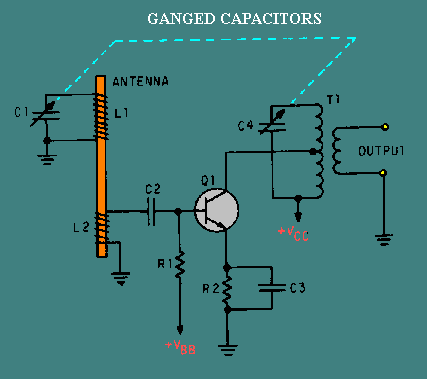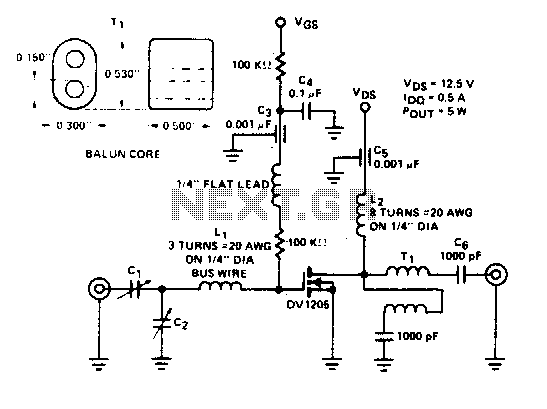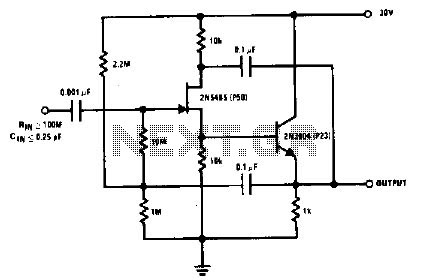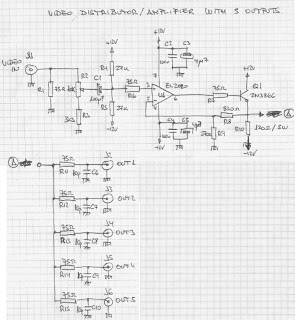
AM radio rf amplifier

A typical RF amplifier is utilized in an AM radio receiver. In the schematic, the input circuit consists of the radio's antenna (L1, a coil), which is part of an LC circuit tuned to the desired station using a variable capacitor (C1). L1 is wound on the same core as L2, enabling the coupling of the input signal through capacitor (C2) to the transistor (Q1). Resistor (R1) is employed to provide the necessary bias to Q1 from the base power supply (VBB). Resistor (R2) ensures proper biasing of the emitter of Q1, while capacitor (C3) serves to bypass R2. Additionally, the primary winding of transformer (T1) and capacitor (C4) form a parallel LC circuit that acts as the load for Q1. This LC circuit is tuned by C4, which is linked to C1, allowing for simultaneous tuning of both the antenna and the LC circuit. The primary winding of T1 is center-tapped to facilitate appropriate impedance matching with Q1.
The RF amplifier circuit described is a crucial component in the functioning of AM radio receivers, enabling the amplification of weak radio frequency signals captured by the antenna. The antenna (L1) is designed as a coil, which, along with the variable capacitor (C1), forms a resonant LC circuit. This configuration allows for selective tuning to the desired radio frequency by adjusting the capacitance of C1, ensuring that only the intended signal is amplified.
The coupling of the input signal to the transistor (Q1) is achieved through capacitor (C2), which blocks any DC component while allowing the AC signal to pass. This ensures that the transistor operates in its active region, where it can effectively amplify the incoming RF signal. The biasing of Q1 is critical for its operation; R1 provides the necessary base bias from the power supply (VBB), while R2 sets the emitter bias, ensuring that the transistor remains in the correct operating state. Capacitor (C3) is included to bypass R2, effectively stabilizing the gain and improving the frequency response of the amplifier by providing a low-impedance path for AC signals.
The load for Q1 is formed by the primary winding of transformer (T1) and capacitor (C4), which together create another LC circuit. This load circuit is also tuned by C4, which is mechanically linked to C1, allowing for simultaneous tuning of both circuits. This dual tuning mechanism enhances the performance of the receiver by maintaining optimal impedance matching and maximizing power transfer. The center-tapped configuration of T1's primary winding is particularly important for ensuring that the impedance seen by Q1 is matched appropriately, thereby enhancing the overall efficiency and performance of the amplifier circuit.
In summary, this RF amplifier circuit exemplifies a well-designed system for AM radio reception, incorporating essential elements such as resonant circuits, proper biasing, and impedance matching to achieve effective signal amplification and tuning.a typical rf amplifier that is used in an AM radio receiver. In figure 2-19, the input circuit is the antenna of the radio (L1-a coil) which forms part of an LC circuit which is tuned to the desired station by variable capacitor C1. L1 is wound on the same core as L2, which couples the input signal through C2 to the transistor (Q1).
R1 is used to provide proper bias to Q1 from the base power supply (VBB). R2 provides proper bias to the emitter of Q1, and C3 is used to bypass R2. The primary of T1 and capacitor C4 form a parallel LC circuit which acts as the load for Q1. This LC circuit is tuned by C4, which is ganged to C1 allowing the antenna and the LC circuit to be tuned together. The primary of T1 is center-tapped to provide proper impedance matching with Q1. 🔗 External reference
The RF amplifier circuit described is a crucial component in the functioning of AM radio receivers, enabling the amplification of weak radio frequency signals captured by the antenna. The antenna (L1) is designed as a coil, which, along with the variable capacitor (C1), forms a resonant LC circuit. This configuration allows for selective tuning to the desired radio frequency by adjusting the capacitance of C1, ensuring that only the intended signal is amplified.
The coupling of the input signal to the transistor (Q1) is achieved through capacitor (C2), which blocks any DC component while allowing the AC signal to pass. This ensures that the transistor operates in its active region, where it can effectively amplify the incoming RF signal. The biasing of Q1 is critical for its operation; R1 provides the necessary base bias from the power supply (VBB), while R2 sets the emitter bias, ensuring that the transistor remains in the correct operating state. Capacitor (C3) is included to bypass R2, effectively stabilizing the gain and improving the frequency response of the amplifier by providing a low-impedance path for AC signals.
The load for Q1 is formed by the primary winding of transformer (T1) and capacitor (C4), which together create another LC circuit. This load circuit is also tuned by C4, which is mechanically linked to C1, allowing for simultaneous tuning of both circuits. This dual tuning mechanism enhances the performance of the receiver by maintaining optimal impedance matching and maximizing power transfer. The center-tapped configuration of T1's primary winding is particularly important for ensuring that the impedance seen by Q1 is matched appropriately, thereby enhancing the overall efficiency and performance of the amplifier circuit.
In summary, this RF amplifier circuit exemplifies a well-designed system for AM radio reception, incorporating essential elements such as resonant circuits, proper biasing, and impedance matching to achieve effective signal amplification and tuning.a typical rf amplifier that is used in an AM radio receiver. In figure 2-19, the input circuit is the antenna of the radio (L1-a coil) which forms part of an LC circuit which is tuned to the desired station by variable capacitor C1. L1 is wound on the same core as L2, which couples the input signal through C2 to the transistor (Q1).
R1 is used to provide proper bias to Q1 from the base power supply (VBB). R2 provides proper bias to the emitter of Q1, and C3 is used to bypass R2. The primary of T1 and capacitor C4 form a parallel LC circuit which acts as the load for Q1. This LC circuit is tuned by C4, which is ganged to C1 allowing the antenna and the LC circuit to be tuned together. The primary of T1 is center-tapped to provide proper impedance matching with Q1. 🔗 External reference





